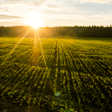- Home >
- Our Actions >
- World report
13
Comments
ECOLOGICAL IMPACT OF EUCALYPTUS TREE PLANTATION ON THE ENVIRONMENT |
|---|
|
by Meena Pandey | 31-01-2020 03:00
|
|
There are high increasing demands for wood for industrial uses and fuel needs, especially in the developing countries of the tropics with their increasing populations. To cope with this situation, people often opt to plant fast growing, highly utilizable, exotic tree species. In Ethiopia different species of Eucalyptus are widely planted for various uses. In the highlands part of Ethiopia, Eucalyptus species are commonly integrated with the various farming systems and their planting has resulted in high economic profitability compared with the agricultural use of land for crop production. The word eucalyptus comes from the Greek words “Eu” and “Kalypta” with the meaning “Well” and “Cover”, respectively and together gives a meaning “well cover”. Therefore, the name eucalyptus refers to a small cap covering the closed flower; it is described as ever green flowering tree and shrub concerning the specific habitats. It is native to Australia and Tasmania with a small number of species also found in New Guinea, the Philippines and Indonesia and has become the most widely planted genus of tree in the world. It covers at least 12 million ha of land throughout the tropical zone, 90% of which have been established since 1955. Outside its native habitat, eucalyptus was first grown in Portugal some four hundred years ago. Eucalyptus is the most commonly grown tree species in government plantation as well as community programme and household woodlots. This tree species grows well even on poor soil and grows faster compared to most indigenous tree species. Smallholders show a clear preference for Eucalyptus poles, which are useful for farm implements and constructing houses and fences. In addition, the sale of Eucalyptus poles and products has the potential to raise farm incomes, reduce poverty, increase food security and diversify smallholder farming systems in many areas of Amhara region and plays a great role as a main source of fuel wood for both urban and rural inhabitants Eucalyptus was introduced with the purpose of providing multipurpose use and rescues the remaining indigenous forests from being destroyed. Ecological impacts of eucalyptus plantation Eucalyptus is not good tree for erosion control. Under dry condition ground vegetation is suppressed by root competition. In areas, where eucalyptus tree are inter cropped with other trees, the problem is minimal and absent, whereas in areas covered with only eucalyptus woodlots there is more soil erosion and gully formation. Most eucalypts are not good trees for erosion control. When young, they are very susceptible to grass competition, and to obtain good growth clean weeding is necessary during the establishment period, which is undesirable on steep or eroding terrain. Even mature stands may be ineffective in halting surface run-off. In eucalyptus plantation area, understory development and litter build-up were insufficient to prevent surface run-off. It is a fast growing, heavy crowned tree which casts a dense shade but little litter. In closed plantations it has a great water demand and an exceptionally extensive and dense root system which enable it to compete successfully for available soil moisture, especially with smaller, shallow rooted plants. Effects on Climate One of the criticisms against Eucalyptus plantations is that they may cause a change in the local climate. This is because of their very high evapo-transpiration rate, which may lead to a lower water table. This high rate of soil water loss is claimed adversely to affect local rainfall levels, resulting in possible desertification of the area. In terms of their effects on regional rainfall or on other regional climatic parameters, however, there is nothing to distinguish eucalypts from plantations of any other tree or from different types of native forests of similar structure and albedo. The effects of the eucalypts on micro-climate at local level are very well recognized. They include lowering of temperature, CO2 fixation, shading etc. In Senegal, for example, microclimate changes occurred when Eucalyptus plantations were established in Acacia forest sites. But the extent of these effects depends on the amount of leaf surface carried by the trees in relation to the surface area of the ground covered. In the shaded area, average air temperatures are lower, extremes of air and surface soil temperatures are reduced and there is a higher surface air humidity compared to areas with no trees. Generally, the greater the leaf area and the more horizontal the leaves are, the greater the shading effect and the higher the evapo-transpiration rate. Eucalypts cast less shade, on average, than other broadleaved trees, but there are big differences in the amount of shade cast by different species because they have different leaf sizes and orientations . Impacts of Eucalyptus on Soil nutrients The effects of Eucalyptus on soil have been noted as it sucks up soil nutrient exhaustion others un specified effects, the tree uses a lot of nutrient which is leading to soil exhaustion and reduction of crop yields. The criticisms on Eucalyptus are argued only on some species, mainly the deep rooted types, that drain water resources, and that poor forestry practices, like high planting densities and short crop rotations, are primarily responsible for depletion of the soil’s nutrients, increased soil erosion, and suppression of the undergrowth. Fast growing and short rotation tree plantations, such as Eucalyptus also use huge amounts of nutrients from the soil in comparison to slow-growing species. Monoculture forest activities, such as Eucalyptus plantations may further affect soil chemical characteristics if the organic litter is continuously raked, prohibiting nutrient recycling. The potential negative impacts of Eucalyptus plantations on soil quality and other ecosystem services have been intensively studied. Across many tropical and sub-tropical regions, there is high demand for soil nutrients as an important drawback to Eucalyptus plantations. Improper land use and soil management, which often leave the soil with less or no vegetation, are often the major causes of soil quality deterioration. However, fast growing tree plantations may also lead to soil quality decline when they are poorly planned and not properly managed. The impact of tree plantations upon soil resources has been very much debated and there is no complete consolidated view, partly due to the fact that the impact is much dependent on variable site and forest conditions Allelopathic effect on agricultural crops Allelopathy is defined as direct and indirect effects of allelochemical compound resulted from organism which may have inhibitor or stimulator effects on the same or different organism. In this process, synthesis of biologically active molecules produced by plant and their residue may convert to other forms and influenced on the growth of similar or non-similar plants. Allelopathic compounds restrict plant growth through negative interactions with important physiological processes such as changes in cell wall structure, prevention of cell division and activity of some enzymes. These compounds can also affect the equilibrium of plant hormones, pollen tube germination, absorption of nutrient elements, displacement of stomata, photosynthesis, respiration, protein synthesis, pigment, and changes in DNA and RNA structures. There have been suggestions that certain species of Eucalyptus may produce chemicals from their leaves or litter that inhibit the germination or growth of other species of plant. There has been the same experimental work which shows that some species of eucalypt do have an inhibitory effect on the associated vegetation. Eucalyptus camaldulensis inhibited improved grassland species. There was more vegetation under oak, in 45% sunlight, than under the eucalypt, in 64% sunlight; soil moisture in the litter zone was greater than in open areas nearby. There is a scarcity of herbaceous plants in the plantations of Eucalyptus in Central Iraq, which was not due to moisture, nutrients or shading; but-leaf extracts, decaying leaves and soil inhibited germination and growth of associated species. References: https://doi.org/10.3329/jbcbm.v5i1.42189 |
|
|










 Previous : Sustainable Clothing Pieces fo...
Previous : Sustainable Clothing Pieces fo...









13 Comments
Hello Meena didi,
Hope you are doing great,
Thank you so much for your informative report on Eucalyptus,
Keep writing,
Green Cheers,
Bindu
Posted 18-07-2021 20:35
Hello meena
I hope you are doing well!
Nice report
Keep writing
Thank you so much for this report!
Looking forward to reading some more reports.
Green cheers!
Best regards
Hema
Posted 19-03-2020 11:37
Greetings meena
I hope you are doing well
Thank you so much for this great report
I hope to read more from you!
Green cheers
Regards
Ishma
Posted 17-03-2020 12:25
Hello meena
I hope you are doing well.
Thank you so much for this report.
Green cheers
Regards
Sus
Posted 07-03-2020 18:47
Hello meena
I hope you are doing well.
Thank you so much for this report.
Green cheers
Regards
Sus
Posted 07-03-2020 18:47
Hello meena
I hope you are doing well
Thank you so much for this report
Regards
Sus
Posted 01-03-2020 10:32
thank you for sharing
Posted 22-02-2020 03:28
Thank you Asmita sis.
Posted 02-02-2020 17:50
Greetings meena sis
I hope you are doing well
Thank you so much for this great report
I hope to read more from you
Green cheers
Regards
Asmita Gaire
Posted 01-02-2020 13:12
Posted 02-02-2020 14:44
Thank you Bibash for yours words.
Posted 31-01-2020 23:31
Hello Meena,
Thank you so much for the detail report,
I had never imagined about such a situation due to the Eucalyptus plantation,
Keep writing.
Posted 31-01-2020 17:52
Thank you dear.
Keep inspiring.
Warm regards,
Meena
Posted 31-01-2020 13:00
New thing add on my mind! Thanks for report @meena
Keep writing reports and keep shining
Regards,
Alok Dhakal
Nepal
Posted 31-01-2020 03:03